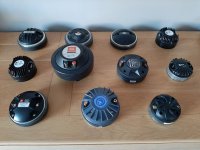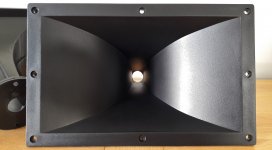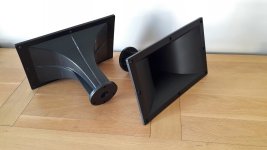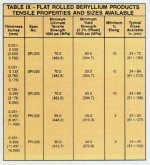At least I have never encounter sub-harmonics at SPL usual for most domestic loudspeaker.
As for the phd thesis of Jack Oclee-Brown I suppose that his main "claim" to the Earl Geddes phase plugs design was that Fresnel zones approach introduced by Earl doesn't ensure equal pressure distribution in the the phase plug channels above the first cavity mode of the compression chamber. Whereas the Smith design approach enable to get equal pressure distribution in the channels at higher frequencies. But, as I understand the Geddes design approach, it enables one to get constant phase volume velocity distribution below the first cavity mode, whereas the Smith design approach does it not. So, what is more important, it is a matter for debate.
This is correct, my approach ignores the radial standing waves in the chamber, which was the only reason for the Smith approach. But as I said in my patent writeup, there is no data that supports Smiths approach as being an advantage. His measurements show differences, but it is not conclusive that they result from his phase plug design nor that they are actually an improvement.
To me, being able to control the volume velocity across the phase plug exit is certainly more important than worry about some standing waves that we don;t even know are a problem.
Smith's work was elegant and his solution well thought out, I just never agreed that there was a problem in need of fixing along this line.
Simulate both?
Be my guest, but understand that this would take a very large and expensive problem to solve. My question would then become - to what end? Are you going to make CDs? Or do you think that the current CD manufacturers are not aware of what we are talking about? Sure they do and I can attest to the fact that B&C was aware - I made them aware.
As DIY, I see no reason to pursue these kinds of investigations since they lead nowhere that we can do anything about. We can only get what is for sale, and that's just fine because by all my research CDs are a commodity and perceptually their designs make little to no audible differences. IMHO all the talk about who makes the "best" CDs is not worth the effort.
But the waveguide does make all the difference, and I applaud Mabat for what he has done here because his work will make a difference (as long as the devices actually get built and tested and the entire thing shown to be valid.)
Too many people get lost in details that don't matter - it's a waste of energy. I understand that the dogma of audio supports this error, but, hopefully, that will subside.
Would you like to be a volunteer?
If you provide the input. I have the tools

As DIY, I see no reason to pursue these kinds of investigations since they lead nowhere that we can do anything about. We can only get what is for sale, and that's just fine because by all my research CDs are a commodity and perceptually their designs make little to no audible differences. IMHO all the talk about who makes the "best" CDs is not worth the effort.
Opinions and experiences seem to vary in this respect.
Regarding "Compression drivers are commodities" versus "specialty products", I find myself somewhere in the middle of the 2 extremes.
When compression drivers are compared, with the same horn, differences are often audible and measurable.
Whether these differences are significant enough is probably a personal matter.
But the waveguide does make all the difference, and I applaud Mabat for what he has done here because his work will make a difference (as long as the devices actually get built and tested and the entire thing shown to be valid.)
I fully agree with this.
From what I've seen, only a few take the full measures (and measurements) to equalize the samples to the "same" frequency response for the listening comparison. Remember that a 1 dB SPL (or even less) can make a major difference. When fairly equalized it can be really tough task. I'm not saying there are no audible differences among all CDs, only that is takes a lot of work to do it correctly, which is often not properly done, to be honest.When compression drivers are compared, with the same horn, differences are often audible and measurable.
Attached are some parts of a comparison between eleven 1" compression drivers. The same horn (Dayton H812) was used for all measurements.
Intentionally, I left out the harmonic distortion plots
Judge for yourself whether the differences are significant.
Intentionally, I left out the harmonic distortion plots
Judge for yourself whether the differences are significant.
Attachments
-
 Compression Drivers.jpg413.1 KB · Views: 302
Compression Drivers.jpg413.1 KB · Views: 302 -
 Dayton-H812-02.jpg254 KB · Views: 295
Dayton-H812-02.jpg254 KB · Views: 295 -
 Dayton-H812-01.jpg224.1 KB · Views: 333
Dayton-H812-01.jpg224.1 KB · Views: 333 -
Large Compression Comparison 1 inch - Frequency Response.pdf1.2 MB · Views: 129
-
Large Compression Comparison 1 inch - Impedance.pdf1.1 MB · Views: 88
-
Large Compression Comparison 1 inch - Temporal Behavior.pdf596.3 KB · Views: 163
-
Large Compression Comparison 1 inch - IMD & Conclusions.pdf984 KB · Views: 111
Last edited:
Attached are some parts of a comparison between eleven 1" compression drivers. The same horn (Dayton H812) was used for all measurements.
Intentionally, I left out the harmonic distortion plots
Judge for yourself whether the differences are significant.
I would just at a guess suggest that no two of these drivers share the same exit angle and I would also guess that none of them are a match to the horn you chose. Given this is it a wonder there are differences. You measurements really don't prove much except that the best measurement is likely the closest match between exit angle of driver to the horn or at the least a best working or complimentary match.
From what I've seen, only a few take the full measures (and measurements) to equalize the samples to the "same" frequency response for the listening comparison. Remember that a 1 dB SPL (or even less) can make a major difference. When fairly equalized it can be really tough task. I'm not saying there are no audible differences among all CDs, only that is takes a lot of work to do it correctly, which is often not properly done, to be honest.
I agree with you completely, but for others I may have to repeat the results of our test yet again.
We compared two identical speakers with different driver sets both EQ'd by my algorithm to be the same. Among some 30 subjects, in a blind test, there was no statistically significant differences found. The drivers were a $3500+ set of TADs (great looking drivers) and $350 set of B&C. While there were no "significant" differences, the B&C had a slight edge. I stopped buying expensive drivers at that point.
So, do you think you wound reliably recognize all those drivers just by their sound? Based on my experience, if the drivers were at least roughly equalized, I don't believe I could.
"Recognize" is a big word in this case. I am quite certain some drivers would stand out, others not so much.
Evidently, the horn used for this test isn't the best match to every driver. Some of these drivers do no lend themselves to a low crossover point, eg. the RCF. Some lack output in the top octave. Finally, diaphragm materials and shapes are definitely a major contributing factor to sound signature imho.
I would just at a guess suggest that no two of these drivers share the same exit angle and I would also guess that none of them are a match to the horn you chose. Given this is it a wonder there are differences. You measurements really don't prove much except that the best measurement is likely the closest match between exit angle of driver to the horn or at the least a best working or complimentary match.
In case you didn't realize it yet, this test was not mine. Why would I buy or otherwise collect eleven 1" drivers, when I already own one of the best (Beyma CP380M), as well as some B&C and BMS 1" drivers?
I permanently switched to 3" diaphragms after comparing 1.75 and 3" drivers at and below 1000Hz. Btw, this is where the CP380M rules, with the exception of a TAD TD2001, or Faital HF20AT behind a deep Salmon horn.
But I prefer a wider sweetspot, so the horn shall be CD.
Last edited:
How can you be so sure? 
As for the exit angle mismatch - I don't have it supported by any experiment but I would be sceptical about discerning audibly a slight mismatch of these angles. Sure, when designing a new waveguide there no reason not to match it precisely but I don't see it as something preventing a useful listening test of different drivers on the same horn. This would also need to be really tested I guess.
As for the exit angle mismatch - I don't have it supported by any experiment but I would be sceptical about discerning audibly a slight mismatch of these angles. Sure, when designing a new waveguide there no reason not to match it precisely but I don't see it as something preventing a useful listening test of different drivers on the same horn. This would also need to be really tested I guess.
But the waveguide does make all the difference
and drivers are commodities and make little difference....so if things sound bad it's the waveguide's fault?
...as long as "sounds bad" is determined in controlled listening conditions to eliminate non-sonic factors.
If you mean "I had a listen and they sounded bad", or "me and my mates had a listen and we all agreed that they sounded bad", then we have fallen through the rabbit hole and all bets are off.
If you mean "I had a listen and they sounded bad", or "me and my mates had a listen and we all agreed that they sounded bad", then we have fallen through the rabbit hole and all bets are off.
....Floyd Toole once told me that he covered nonlinear distortion in his book at the level it deserved - it was one paragraph in the entire book. That says a lot.
Toole would probably* also say that compression drivers and larger-than-standard-dome-tweeter-guide waveguides are absolutely unnecessary in home audio, in that they make no difference worth noting. Would that also say a lot?
*just an informed guess
To my knowledge Floyd has never said that, and in my experience with him, he wouldn't. Floyd and I have gone around and around on the issue of directivity, where we don't totally agree. Over the years I believe that he has come further to my approach than I have to his. A waveguide on a dome tweeter has problems with higher DI designs, which are conveniently cured with CDs. Yes the power output of CDs for home use is well over what one actually needs, but it surely doesn't hurt. But if one wants a high DI design with constant directivity then CDs are the way to go.
So no, I don't agree with your belief in what Floyd would say.
So no, I don't agree with your belief in what Floyd would say.
If you mean "I had a listen and they sounded bad", or "me and my mates had a listen and we all agreed that they sounded bad", then we have fallen through the rabbit hole and all bets are off.
I completely agree with you here.
- Home
- Loudspeakers
- Multi-Way
- Acoustic Horn Design – The Easy Way (Ath4)
 This is all I can offer at the moment.
This is all I can offer at the moment.
